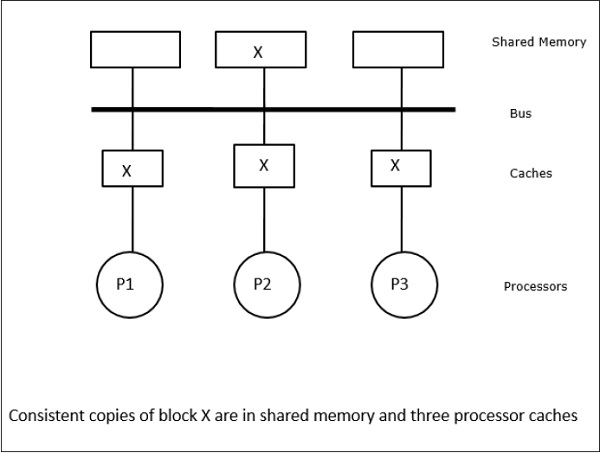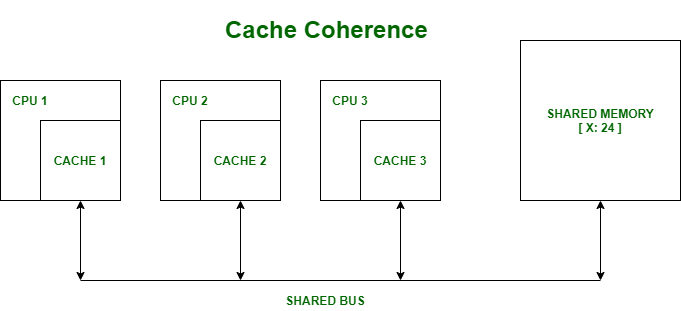Describe the Three Levels of Cache Used by a Processor
Two alus to process two instructions at once registers Cache io unit. Additional techniques are used for increasing the level of parallelism when.

Cache Coherence And Synchronization
So does the CPU cache size make a difference to performance.

. Cache currently comes in three levels L1 L2 and L3. L1 L2 and L3. Every modern processor comes with a dedicated cache that holds processor instructions and data meant for almost immediate use.
A level 2 cache L2 cache is a CPU cache memory that is located outside and separate from the microprocessor chip core although it is found on the same processor chip package. First off theres several of them. Theres the L1 data cache but theres also a L1 instruction cache and eg.
Earlier L2 cache designs placed them on the motherboard which made them quite slow. The L3 Cache memory is an enhanced form of memory present on the motherboard of the computer. For example an eight-core chip with three levels may include an L1 cache for each core one intermediate L2 cache for each pair of cores and one L3 cache shared between all cores.
There are three distinct level of cache coherence -. Main memory or primary memory. Cache coherence is the discipline that ensures that changes in the values of shared operands are propagated throughout the system in a timely fashion.
Memory on the processor chip is called level 1 cache. Intel Core CPUs also have another instruction cache the uOp cache which is depending on your point of view either a parallel L1 instruction cache or a L0 instruction cache. Types of Cache Memory.
The two major manufacturers. There is three types of cache. CPU Cache memory is divided into three levels.
The reason it comes in such small amounts is the manufacturing cost and density. Optical disks or magnetic types or tertiary Memory. 1 2 3.
Some processors use a third cache farther from the processor core but still in the processor package which is called Level 3 cache L3 cache. L2 cache or secondary cache is often more capacious than L1. Memory on the processor die is called Level 1 cache L1 cache.
External to the processor Main Memory L3. Cache hierarchy is a form and part of memory hierarchy and can be considered a form of tiered. It is an extra cache built into the motherboard between the processor and main memory to speed up the processing operations.
L1 is the fastest and has the least amount of storage while L2 and L3 become slower but have higher storing capacity. Memory in the processor package but not on the processor die is called Level 2 cache L2 cache. This serves as another bridge to park information like processor commands and frequently used data in order to prevent bottlenecks resulting from the fetching of these data.
This cache is small and its access time is comparable to that of processor registers. 21300 PC4-List and describe the components found in a Pentium processor. It is referred to as the level 2 L2 cache.
L2 cache may be embedded on the CPU or it can be on a separate chip or coprocessor and have a high-speed alternative system bus. L2 is usually a separate static RAM SRAM chip and it is located between the CPU and DRAM Main memory. Memory further from the processor core then L2 cache but still within the processor housing.
In Memory Hierarchy the cost of memory capacity is inversely proportional to speed. Memory in the processor package but not on the processor die is called Level 2 cache L2 cache. The term cache hit means the data or instruction processor need is in cache cache miss in the opposite situation.
This is referred to as the first level cache. Generally the L1 cache is the smallest in size and built into the processor chip. Part of the processor chip Primary Cache L1 2.
Memory on the processor die is called Level 1 cache L1 cache. Cache memory within a computer is classified under various types depending upon its physical location within the computer whether they are. Memory in the processor package but not on the processor die is called Level 2 cache L2 cache.
Cache hierarchy or multi-level caches refers to a memory architecture that uses a hierarchy of memory stores based on varying access speeds to cache data. Shared highest-level cache which is called before accessing memory is usually referred to as the last level cache LLC. The memory hierarchy is again according to the speed and thus the size of the cache.
Some processors use a third cache farther from the processor core but still in the processor package which is called Level 3 cache L3 cache. Memory on the processor die 2. Every write operation appears to occur instantaneously.
Secondary Cache Secondary cache is placed between the primary cache and the rest of the memory. There are multiple different kinds of cache memory levels as follows Level 1 L1 or Registers It is a type of memory in which data is stored and accepted that are immediately stored in the CPU. In a fully associative cache every memory location can be cached in any cache line.
L1 cache or primary cache is extremely fast but relatively small and is usually embedded in the processor chip as CPU cache. In multi-core CPUs a separate L1 cache is available for each core. L1 is usually part of the CPU chip itself and is both the smallest and the fastest to access.
There are three general cache levels. Primary Cache A primary cache is always located on the processor chip. Highly requested data is cached in high-speed access memory stores allowing swifter access by central processing unit cores.
Located between the processor and main memory Secondary Cache L2 3. It separates the computer storage based on hierarchy. The Levels of CPU Cache Memory.
Cache is graded as Level 1 L1 Level 2 L2 and Level 3 L3. All processors see exactly the same sequence of changes of values for each separate. L1 L2 and L3.
Describe the three levels of cache used by a processor. Magnetic disks or secondary memory. Memory within the processor housing but not on the processor die 3.
Examples of L1 cache are. Memory on the processor die is called Level 1 cache L1 cache. Techopedia Explains Level 3 Cache L3 Cache The L3 cache is usually built onto the motherboard between the main memory RAM and the L1 and L2 caches of the processor module.
Level 3 or L3 Cache Memory. L1 Level 1 cache is the fastest memory that is present in a computer system. L1 cache is die.
Its size is often restricted to. Some processors use a third cache farther from the processor core but still in the processor package which is called Level 3 cache L3 cache.


No comments for "Describe the Three Levels of Cache Used by a Processor"
Post a Comment